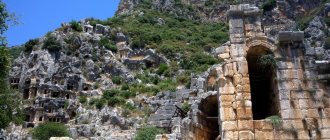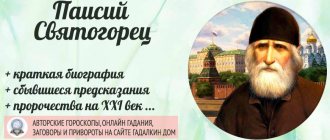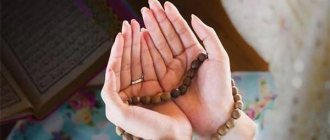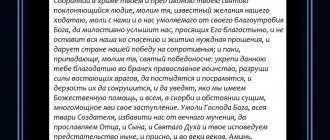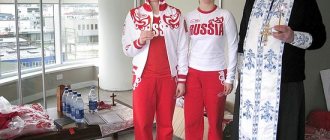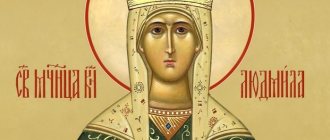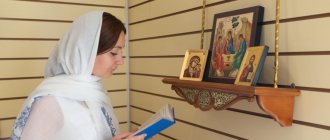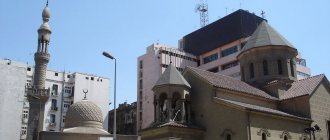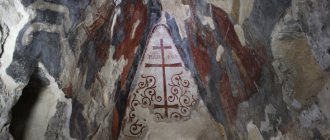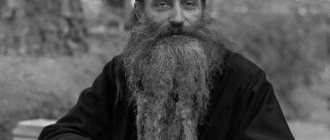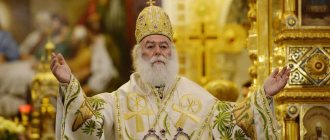Turkish Orthodox Church
, a schismatic religious organization.
It was formed in 1922 by order of the Turkish government, which tried to create a “national” Orthodox Church, not associated with Greek Orthodoxy, and accordingly with Greek nationalism. The church was led by Paul Karakissaridis, a Turkish-speaking Greek from Asia Minor. This was an attempt to tear the Greeks living in Turkey away from Greece and make them patriots of young Turkey. This idea failed - except for a small number of Orthodox Turks and a minimum of Greeks, no one joined this new formation. Paul himself, after declaring himself a “patriarch,” took the name Eftim and changed his Greek surname to a Turkish one - Ernerol.
At the beginning of the existence of the church, Eftim managed to gain a small number of followers; on June 1, 1923, they tried to kidnap Patriarch Meletius IV, and on October 2, Pope Eftim besieged the Synod of the Church of Constantinople and appointed his own Synod, trying to carry out a coup in the church, and for a short time occupied the building of the patriarchate. After the election of a new patriarch in December of the same year, the self-proclaimed Pope and Patriarch repeated the action, but this time the police quickly expelled him.
In 1924, he captured the Church of Mary in Galata (the area of Istanbul where he had the largest number of supporters). On June 6, it was decided to move the residence of the “Turkish Orthodox Patriarchate” from Kayseri to Istanbul.
In 1926, Eftim captured the second church in Galata. However, the Turkish government soon stopped supporting the church openly, and after the death of Ataturk, it lost support altogether.
In 1956, Eftim captured two more Orthodox churches in Galata. After Eftim fell ill, his son Turgut (George) Ernerol took the throne under the name Eftim II.
The church has always been extremely small in number, but existed until recently and even had two communities outside of Turkey (it is not clear how real). World Orthodoxy does not recognize this movement due to numerous canonical violations, including married episcopacy and Turkish nationalism.
After the death of Eftim II, his brother Seljuk Ernerol became patriarch. After his death, the existence of the church is doubtful, since apart from the Ernerol family there are no more believers in it, the churches do not function due to the lack of priests. This is probably where her story ends.
History of origin
The fall of the Ottoman Empire at the beginning of the 20th century provoked a series of bloody wars. The term genocide is not officially used to describe these events, but millions of Armenians and Greeks were forced to leave territories inhabited for centuries and leave Turkey. The overwhelming majority professed Orthodoxy.
On September 15, 1922, with the support of the Young Turks, the Autocephalous Turkish Orthodox Church was founded. The idea of creation belongs to the famous reformer and military leader Mustafa Kemal Ataturk. The initiative had to accomplish 3 tasks:
- Severance of relations between the new state and the Patriarchate of Constantinople.
- Creation of a church with a national-patriotic slant for the remaining Greeks and Albanians.
- State control over “unreliable” religious minorities.
A native of Asia Minor, Pavel Karahisaridis, was appointed head. He proclaimed himself patriarch, took the name Eftim I and took the Turkish surname Erenerol.
The first time after its founding, the new patriarch managed to gather a small number of parishioners from Orthodox Turks. The Greeks did not accept the new church. In subsequent years, the number of national religious organizations only decreased.
Türkiye is a secular state. Islam dominates here
Türkiye is officially called the Republic of Turkey. This state is unique in that it is located in both Asia and Europe. In addition, on its territory there are shrines of several world religions. Modern Turkey was formed in 1923 after the collapse of the Ottoman Empire as a result of its defeat in the First World War.
This defeat gave rise to the national liberation war of the Turkish people, which led to the overthrow of the monarchy and the creation of a Turkish national state in the territory of eastern Thrace, Asia Minor and the Armenian Highlands.
Modern Turks. In Turkey, religion is constitutionally separated from the state, with Islam dominating the country. Photo: upload.wikimedia.org
Religion in Turkey is legally separated from the state, and freedom of religion is guaranteed to every resident of the country. Article 3 of the country's Constitution states: “The Republic of Turkey is a democratic, secular and social state based on the rule of law; based on the concept of public peace, national solidarity and justice; respectful of human rights, faithful to Atatürk’s nationalism and based on the main principles set out in the preamble.”
In addition, Art. 24 establishes the right to freedom of conscience, religion and religious beliefs. In addition, it establishes the right to free expression of religious beliefs.
96% of the population
Turkey practices Sunni Islam
Education and training in religion and ethics in Turkey is carried out under the control and supervision of the state. Education in religious culture and ethics is a mandatory element in the curriculum of primary and secondary schools.
It should be noted that after the 1980 coup d’etat, the strategy of “Turkish Islamic synthesis” was adopted, when the government began to rely more on religious institutions.”
Video: Sufi brotherhoods - tariqas (narrated by Islamic scholar Roman Silantiev). At 45 seconds, the author begins to talk about the history of Sufi tariqah orders.
It is quite easy to answer the question: what is the main faith of the Turks. The fact is that 96% of the country's residents profess Sunni Islam: Hanafi madhhab and Maturidism. In addition, Islamic brotherhoods - tariqas - are very common in Turkey.
The most famous of them are the Naqshbandi and Mevlevi tariqats. The Shafi school of thought is practiced mainly by Kurds. In addition, 321 communities of various Christian denominations and trends, 36 Jewish synagogues, 60 communities of Assyrian-Nestorians, Orthodox Bulgarians, Arabs and Armenian Catholics, and 52 communities of various Protestant trends are registered in the country. In addition, some Kurds in the east of the country profess a syncretic religion and are called Yazidis.
Current state
Today the structure operates at the expense of the state. There are 3 churches and 5 communities under control. The head is Eftim IV. The position of patriarch is inherited among relatives. Most parishioners are members of the same family.
The cathedral is located in Istanbul. The Temple of the Kaffa Mother of God was founded in 1583 by settlers from Feodosia. The cathedral is also the residence of Eftim IV and his family. All rituals and liturgies are conducted in Turkish. The remaining churches of autocephaly do not hold services.
Interesting fact
In October 2022, the patriarch of the Turkish National Church criticized the recognition of the autocephaly of the Orthodox Church of Ukraine as one of the 15 local churches in the world. Eftim IV filed a lawsuit against the head of the Patriarchate of Constantinople, Bartholomew.
The lawsuit was later rejected, but the story helped draw attention to the small and unknown autocephaly and make itself known.
Shrines
ISTANBUL (CONSTANTINOPLE).
Cathedral of St. George the Victorious of the Orthodox Church of Constantinople. Relics and icon:
- mts. Solomonia (mother of the Maccabee brothers),
- mts. Euphemia All-Praise (IV century),
- St. Empress Feofaniya (IX century),
- St. John Chrysostom (?),
- St. Gregory the Theologian (?),
- Icon of the Mother of God "All-Blessed".
Monastery of Our Lady Balykli of the Constantinople Orthodox Church:
- Icon of the Mother of God “Life-Giving Source”,
- Icon of the Mother of God “Annunciation of the Blessed Virgin Mary”.
RUINS OF EPHESUS. Destroyed Church of St. John the Evangelist:
- grave of the ap. John the Theologian.
ANCIENT HIERAPOLIS (Pamukkale):
Orthodox churches in Turkey
90% of believers in the state profess Islam. However, this country is considered the cradle of Christianity.
In the 1st and 2nd centuries, the Apostle Paul and his disciples continued to enlighten people here. Andrew the First-Called founded the Church of Constantinople. Nicholas the Wonderworker lived and worked in these lands. The Byzantine state was the main world center for the development of Christianity.
In Turkey, examples of architectural heritage built from the 1st century AD until the collapse of the Ottoman Empire have been preserved and are protected by the state.
Saint Sophie Cathedral
The construction of the symbol of the “golden age” of Byzantium began in the 4th century. By the 6th century, the temple became the main decoration and heart of Constantinople. After the capital was captured by the Ottomans in the 15th century, the architectural gem was converted into a mosque. Since 1935, the temple has been a museum.
The facades of the three-nave, single-domed basilica are decorated with numerous mosaic compositions. The interior decoration was improved over 15 centuries. The cathedral is famous for its combination of Christian and Islamic traditions in the most masterly execution. The wealth and variety of precious materials used in the decoration amaze the imagination.
Church of St. Irene
The temple was built on the occasion of the Second Ecumenical Assembly in 381. Unlike most Christian buildings in Turkey, the church was not converted into a mosque, but was used as military warehouses. In the 19th century there was an archaeological museum and then an Imperial Museum.
Today, exhibitions and concerts are held in the church building.
Church of Saints Sergius and Bacchus
The most ancient temple in Istanbul was built in the 6th century under the personal control of the glorious Justinian. According to legend, thanks to the patron saints of the warriors Serius and Bacchus, the young ruler escaped execution for attempting to assassinate Emperor Anastasius. They appeared to him in a dream and begged for mercy.
The church is called Little Sophia for its similarity with the temple of the same name. During the Ottoman period, a minaret was added to the building. The mosque is open daily to this day.
Church of Our Lady of Pammakaristos
The only surviving example of Palaiologan period architecture in Istanbul. The church was built in honor of the good news of the Archangel Gabriel about the divine conception of Mary.
Unfortunately, it is difficult to judge the interior decoration of the temple. Only some fragments of mosaics from the 14th century have survived. The most famous of them is the golden image of the Savior in the dome.
Since 1591, the church has been converted into a mosque and is called Fethiye Jami. The architectural monument is open to the public partly due to daily Muslim rituals.
Church of Christ the Savior in the Fields
The cathedral is located on the territory of the ancient Chora Monastery on the outskirts of Istanbul. Built in the first half of the 14th century. After the conquest of Constantinople by the Ottomans, the church was completely plastered from the inside and turned into a mosque.
In 1948, during restoration work, a layer of putty was removed and an incredibly beautiful example of Byzantine decor in excellent condition appeared to the world. Today the church has become a museum.
Most churches and temples from the Byzantine period are protected by UNESCO. Cappadocia, the Lycian Worlds, and the old districts of Istanbul are favorite places of pilgrimage for Christians from all over the world.
Despite the secular nature of the Turkish state, Islam predominates in the country
What religion dominates among the Turks is indicated in population census data. They say that the first religion in Turkey in terms of number of adherents and importance is Islam. The establishment of Islam in the territory of modern Turkey was completed by the second half of the 11th century, when the Seljuk Turks expanded into Eastern Anatolia.
Today, 99.8% of Turkey's population is Muslim. Moreover, about 80% of Muslims are Sunnis, and Shia Alevis make up about 20% of the Muslim population. About 3% of the Muslim population are Twelver Shiites.
"Portrait of Sheikh-ul-Islam." Hood. Ali-bek Huseyn-zade. The spiritual leader of the Ottoman Empire, Sheikh-ul-Islam, controlled the power of the Sultan by issuing fatwas. Photo: upload.wikimedia.org
In the Ottoman Empire, the spiritual power of the country was controlled by Sheikh-ul-Islam, the highest Muslim cleric of the empire. At the same time, the Islamic clergy had great influence, since by the 19th century the inalienable possessions in their hands (waqf lands) accounted for almost a third of all cultivated land in the empire.
At the same time, Sheikh-ul-Islam had the exclusive right to interpret the decision of the imperial authorities from the point of view of the Koran and Sharia. He controlled the power of the Sultan, since he could issue fatwas approving or disapproving of the ruler's decrees.
In the Ottoman Empire, Sheikh-ul-Islam controlled the power of the Sultan.
In the Ottoman Empire, all other religions were put in a subordinate position. The patriarchs of the Greek Orthodox and Armenian Gregorian communities, as well as the chief rabbi of the Jewish community, were installed as mediators between the Sultan and the non-Muslim population.
The sultans granted favors to the heads of communities as payment for keeping their flock in obedience. In the 19th century, religion began to slow down the country's progress.
At the same time, Türkiye suffered a number of defeats in wars. So in 1856, after the end of the Crimean War, the “Decree on Reform” was adopted. He equated the religious rights of non-Muslims with the rights of Muslims.
Some taxes and laws restricting their rights were abolished. The Constitution of the Ottoman-Turkic State of 1860 gave non-Muslims the right to participate in government.
Links
National Bulgarian Alternative Synod • Belarusian Autocephalous Orthodox Church • Gregorian Schism • Catholic Orthodox Church of Portugal • Lubensky Schism • Macedonian Orthodox Church • Holy Metropolis of Abkhazia • Turkish Orthodox Church • Ukrainian Autocephalous Orthodox Church • Ukrainian Autocephalous Orthodox Church (renewed) • Ukrainian Ukrainian Orthodox Church of the Kiev Patriarchate • Croatian Orthodox Church • Montenegrin Orthodox Church Reformist and syncretic Apostolic OC • Mother of God Center • TOC (Raphael) • Catholic OC of France • Renovationism • Patriarchate of the Russian IP Catacomb Church • Russian Catacomb Church of True Orthodox Christians • Ukrainian Autocephalous OC-canonical • Ukrainian Reformed OC • Church of St. John the Evangelist Old Believers Russian Old Orthodox Church • Russian Orthodox Old Believer Church • Russian Orthodox Old Believer Church in Romania • Old Orthodox Church of Russia (Apollinarians) • Old Orthodox Church of Christ of the Belokrinitsky hierarchy • Neokruzhniki • Old Orthodox Pomeranian Church • Eastern Old Believer Church
Excerpt characterizing the Turkish Orthodox Church
Napoleon spent the entire day of August 25, as his historians say, on horseback, inspecting the area, discussing the plans presented to him by his marshals, and personally giving orders to his generals. The original line of Russian troops along Kolocha was broken, and part of this line, namely the Russian left flank, was driven back as a result of the capture of the Shevardinsky redoubt on the 24th. This part of the line was not fortified, no longer protected by the river, and in front of it there was only a more open and level place. It was obvious to every military and non-military person that the French were supposed to attack this part of the line. It seemed that this did not require many considerations, there was no need for such care and troubles of the emperor and his marshals, and there was no need at all for that special highest ability called genius, which they so like to attribute to Napoleon; but the historians who subsequently described this event, and the people then surrounding Napoleon, and he himself, thought differently. Napoleon drove across the field, thoughtfully peered at the area, shook his head with himself in approval or disbelief, and, without informing the generals around him of the thoughtful move that guided his decisions, conveyed to them only final conclusions in the form of orders. After listening to Davout's proposal, called the Duke of Ecmul, to bypass the Russian left flank, Napoleon said that this did not need to be done, without explaining why it was not necessary. To the proposal of General Compan (who was supposed to attack the flushes) to lead his division through the forest, Napoleon expressed his consent, despite the fact that the so-called Duke of Elchingen, that is, Ney, allowed himself to note that movement through the forest was dangerous and could upset the division . Having examined the area opposite the Shevardinsky redoubt, Napoleon thought for a while in silence and pointed to the places where two batteries were to be set up by tomorrow to operate against the Russian fortifications, and the places where field artillery was to be lined up next to them. Having given these and other orders, he returned to his headquarters, and the disposition of the battle was written under his dictation. This disposition, about which French historians and other historians speak with delight, was as follows: “At dawn, two new batteries, arranged in the night, on the plain occupied by the Prince of Eckmuhl, will open fire on two opposing enemy batteries. At the same time, the chief of artillery of the 1st Corps, General Pernetti, with 30 guns of the Compan division and all the howitzers of the Dessay and Friant divisions, will move forward, open fire and bombard the enemy battery with grenades, against which they will act! 24 guns of the Guards artillery, 30 guns of the Compan division and 8 guns of the Friant and Desseux divisions, a total of 62 guns. The chief of artillery of the 3rd Corps, General Fouche, will place all the howitzers of the 3rd and 8th Corps, 16 in total, on the flanks of the battery, which is assigned to bombard the left fortification, which will total 40 guns against it. General Sorbier must be ready, at the first order, to march with all the howitzers of the Guards artillery against one or another fortification. Continuing the cannonade, Prince Poniatowski will head towards the village, into the forest and bypass the enemy position. General Compan will move through the forest to take possession of the first fortification. Upon entering the battle in this way, orders will be given according to the actions of the enemy. The cannonade on the left flank will begin as soon as the cannonade of the right wing is heard. The riflemen of Moran's division and the Viceroy's division would open heavy fire when they saw the beginning of the attack of the right wing.
